
The PlayStation 5 is a clear declaration that Sony believes in the generational format, confident that each new piece of console hardware should push the medium forward in a significant way. This is the opposite of Microsoft’s mantra, which is determined to ensure nobody is left behind with the Xbox Series X and Xbox Series S.
Despite the assured message, the PS5 embraces its past more than I anticipated. But it also carves out an innovative path into the future, one that showcases how gaming experiences still have so much potential for increased player immersion and convenience. The result is a fantastic console with only a few notable shortcomings.
The PS5 is strikingly similar to its predecessor in many ways, carrying over much of the existing ecosystem so that consumers can transfer their games, saves and online identity with minimum fuss. But with every thread of resemblance comes a modification, whether it’s the wondrous DualSense controller or the endless quality-of-life changes provided by the SSD storage.
Everything feels smoother, making the act of jumping into games so much more inviting. While the PS5 doesn’t reach the high standards of backwards compatibility and performance of its competitors, this remains a piece of hardware with much potential, teasing a coming generation that will be filled with brilliant games, exciting advantages and many more surprises to look forward to.
But right now, how does the PS5 fare against what came before it? Will hardcore and casual consumers alike benefit from spending £449/£359 on the new console, despite a fairly small selection of launch titles. The answer is complicated, but one that’s ultimately slathered in positivity for what could be Sony’s best machine yet.
Related: Best PS5 Games
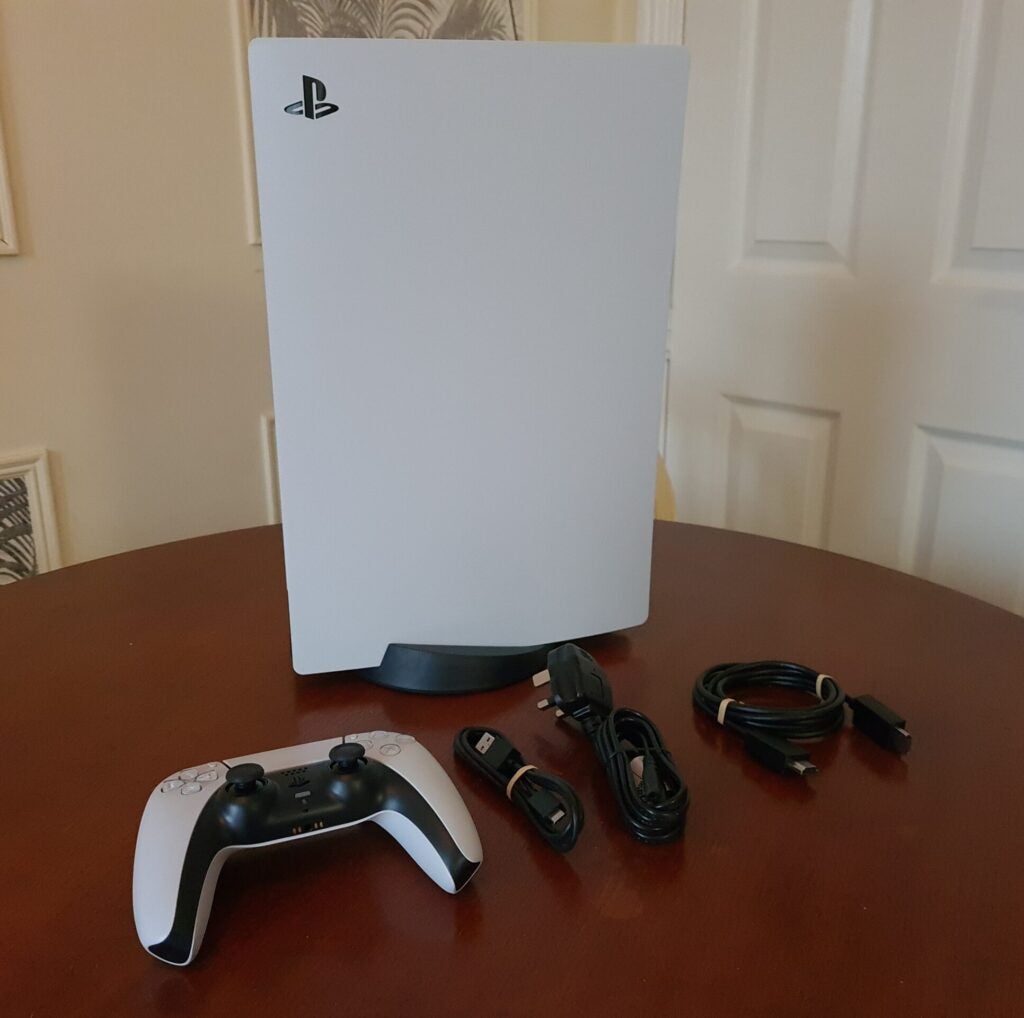
PS5 Review – Design and connectivity
For some time now, Sony has embraced black as the primary colour of its console designs, with the exception of the original PlayStation. So much so, that it has become synonymous with the brand itself. So when the PS5 was unveiled to be a colossal tower of white plastic, many of us turned our heads in hesitation.
While the design will undoubtedly be polarizing, I’m a fan of the new PS5, even if it will prove far too large for the majority of entertainment centres. The console is massive, measuring 390mm x 260mm x 104mm if you opt for the version with a 4K Blu-ray drive. The digital edition will be slightly slimmer, but not by much, meaning you’ll still require a similar amount of space to house the console.
On the console itself you’ll see a rather simplistic selection of buttons and inputs. The front is home to a single USB-A 3.0 port and a USB-C port. Move downward and you’ll see the power and eject buttons, which are no less easier to tell apart than they were on the PS4. These sit embedded in a layer of plastic, which is great at attracting fingerprints – and likely scratches, if you’re trying to insert devices into the USB slot without looking.
Around the back is the power input, an Ethernet cable port and two additional USB 3.0 ports, which will be perfect for accepting charging cables or connecting dongles belonging to a Bluetooth headset or similar accessories. Three is arguably the magic number, although I did find myself having to swap things out when transferring games onto the internal SSD via an external hard drive.
Related: Upcoming PS4 Games
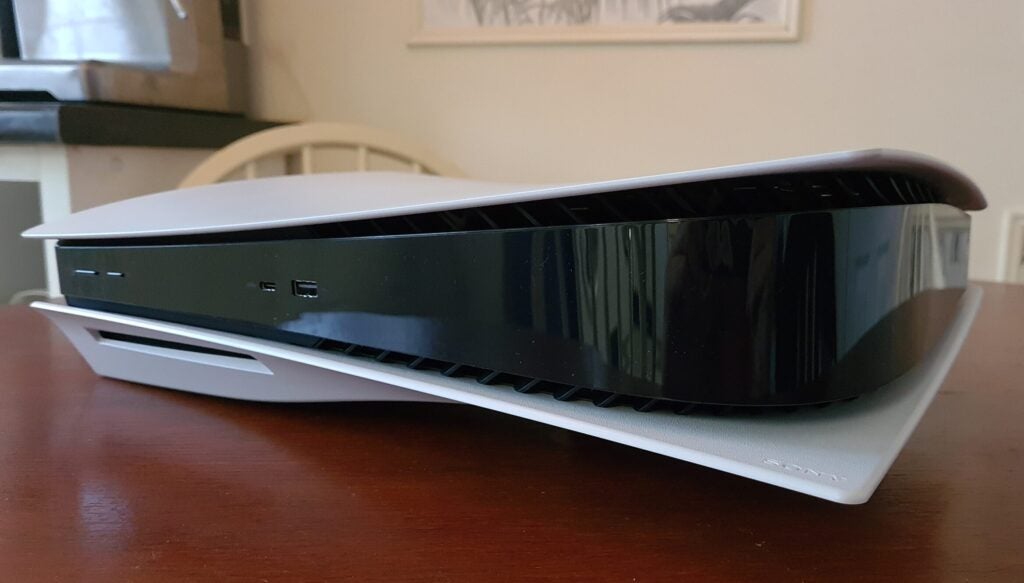
As you may have seen from the official teardown, the white slabs of plastic on either side of the PS5 are easily removable, granting immediate access to the console’s innards for dust removal and replacement of the NVMe SSD storage.
It’s great to see that Sony has designed this console to be customisable within a matter of moments, and there’s even potential for custom designs and some truly fascinating limited edition bundles. Sadly, none of that is enough to detract from the PS5’s obtrusive size, which I still feel is likely to prove an inconvenience when trying to find a home for it in any modern setup.
The console can be placed either horizontally or vertically in the included stand, which itself feels quite cumbersome to locate without fear of scratching the polar white exterior. Compared to the Xbox Series X, the overall build quality here feels like a notable step backwards. Microsoft’s console feels like a premium device in every way, while the PS5 feels toy-like and delicate, and might struggle in terms of form factor to sit alongside existing hardware.
The machine is dominated by plastic on all sides, which makes it feel relatively cheap. It’s not egregious, but I’d expect more from a console retailing for £449. Fortunately, the lacklustre build quality doesn’t translate across to the DualSense controller, which is a beautiful piece of hardware and easily the console’s highest point. It’s what makes the PS5 feel like a true next-generation platform – but we’ll be diving into exactly how this is achieved later on.
Unlike its rival, the PS5 is a little more flexible when it comes to replacing or upgrading storage; it doesn’t require the installation of proprietary cards from Seagate. Simply remove the appropriate parts of the console and replace the existing NVMe drive with one of similar size and speed, and be aware that you’ll need to implement an SSD of equal or faster specs in order to run games developed specifically for the PS5. If you don’t, they simply won’t be compatible with the console.
Related: PS5 vs Xbox Series X
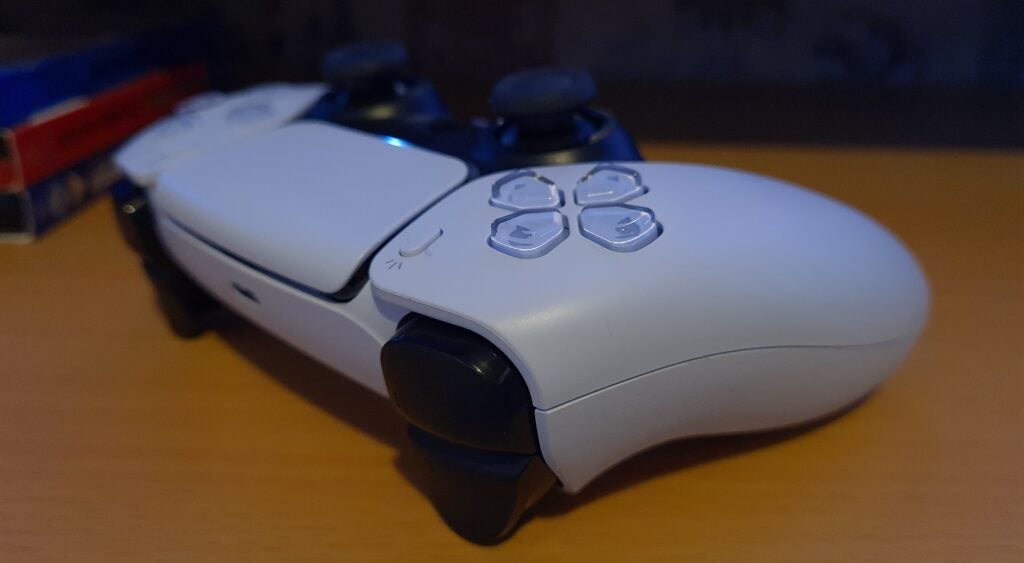
PS5 Review – Specs and technology
Even when compared to the more than capable PS4 Pro, the PS5 is in another league entirely for the sheer horsepower and technical specifications contained within. It’s an incredibly powerful machine, and beyond a few notable omissions, it easily stands shoulder-to-shoulder with the Xbox Series X. Sony is emphasising speed, accessibility and the potential for enhanced visuals and resolution above all else, and the components inside the console more than support that goal.
The PS5 is powered by an AMD Zen 2 processor comprising eight cores running at variable frequencies, with the clock speed topping out at a respectable 3.5GHz. The GPU is also an AMD custom unit, capable of reaching a maximum of 10.28 teraflops at 2.23GHz. This doesn’t match up to Microsoft’s flagship offering, but it’s more than sufficient to maintain performance and graphical features such as hardware-accelerated ray tracing.
In fact, it capitalises upon the latter far more than the competition in games such as Marvel’s Spider-Man: Miles Morales, where it showcases how the new graphical technology can be genuinely transformative in the right circumstances. At the time of writing, Microsoft is yet to release a first-party exclusive that supports the feature.
Elsewhere, the PS5 includes 16GB of GDDR6 memory with an impressive bandwidth of 448GB/s. Sony has also implemented Wi-Fi 6 and Bluetooth 5.1, with the former allowing for some outstanding download speeds. Through my home internet connection, I managed to install a 40GB file in roughly 30 minutes – and the console will blister through a list of downloads with absolute ease, so long as your hard drive has enough space available. On a Wi-Fi 6 compatible router, the internal speed test gave me download speed 140.6Mbps, which made downloading large games a breeze.
Related: Best Xbox Games
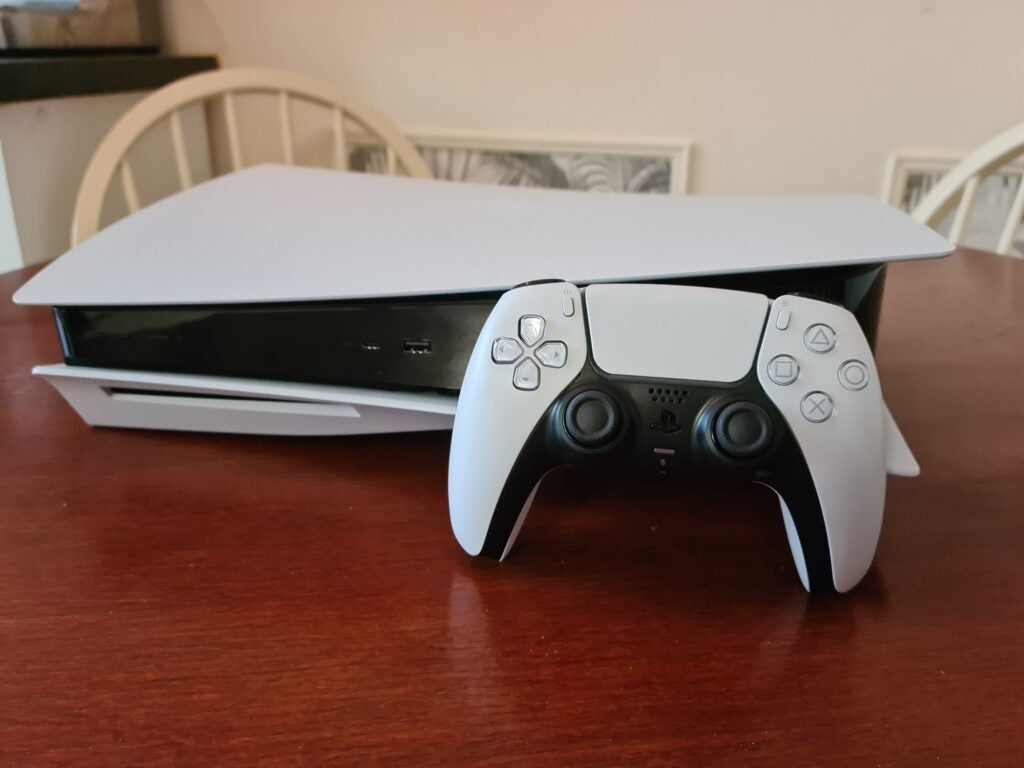
In terms of storage, the PS5 has an 825GB SSD, of which a small percentage will be automatically allocated to the system itself, so it can’t be used for games and applications. This leaves you with 667.2 GB to play with. It’s a commendable amount of storage, but I still found myself having to frequently delete games to make room for others throughout the review process.
Avid players will definitely want to pursue an upgrade in the months to come. It’s a shame such a process is so expensive. Sony has said any that exceed a 5.5GB/s read speed should be compatible, which includes recent products from Samsung and Western Digital.
3D audio is being hailed as a major feature of the new generation, a feat achieved by the console’s Tempest Engine. This allows for hundreds of simultaneous audio sources to be registered at once, instead of being limited to 50 as in the PS4 and PS4 Pro.
PS5 Review – Graphics and performance
Currently, we have access to only a selection of next-generation exclusives in the form of Marvel’s Spider-Man: Miles Morales, Devil May Cry 5 and Bugsnax. As a result, we had to be somewhat creative when evaluating the performance of platforms. Just like the Xbox Series X, PS5 is capable of 120fps performance when paired with displays that support HDMI 2.1, although there’s a very small number of games which can reach such echelons of performance right now.
Given its heavy focus on backwards compatibility, I decided to compare some of the platform’s biggest exclusives across PS4 Pro and PS5 Pro. The improvements are immediately pronounced when it comes to loading times, as you can see from the results below. All of the tests were done by loading into a save file directly from the main menu.
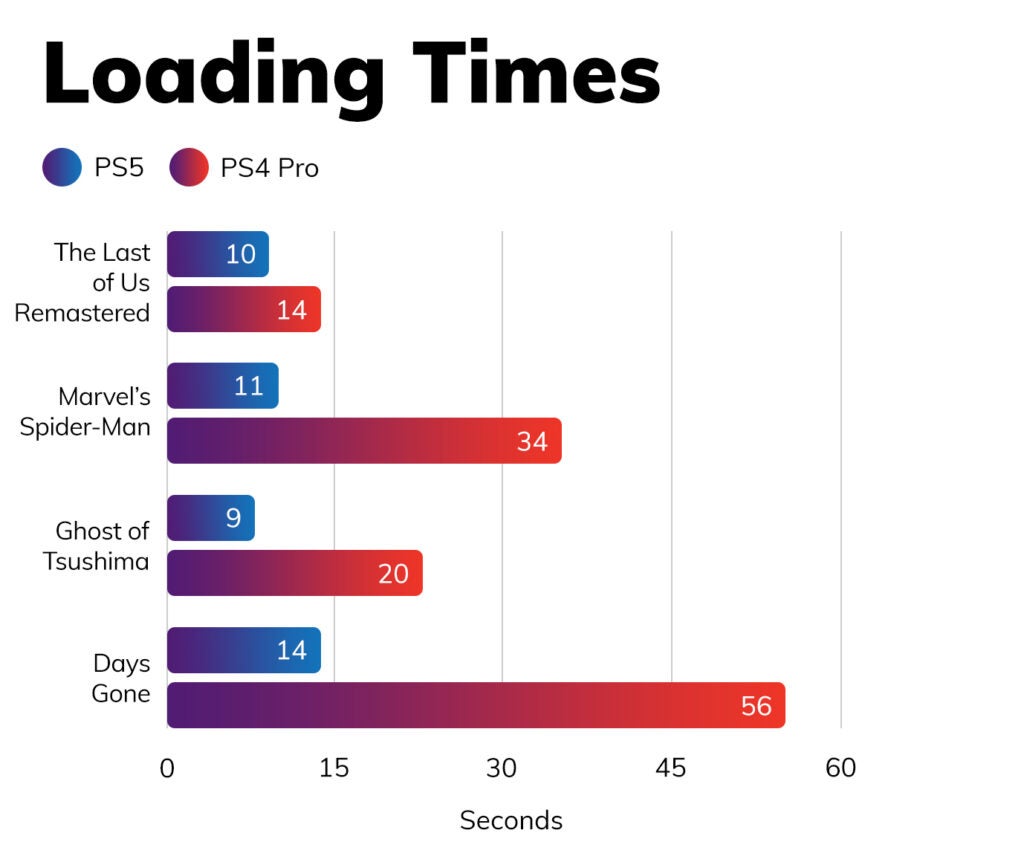
The speed at which you can load existing games is welcome, although it never reaches the heights of Xbox Series X. When comparing the PS5 against Microsoft’s console in a selection of third-party experiences, the latter came out on top every time. It’s likely that the Series X is far better optimised when it comes to backwards compatibility, while Sony is instead focusing on next-generation experiences. For example, the process of booting up Miles Morales to reach actual gameplay is a mere 7 seconds on PS5.
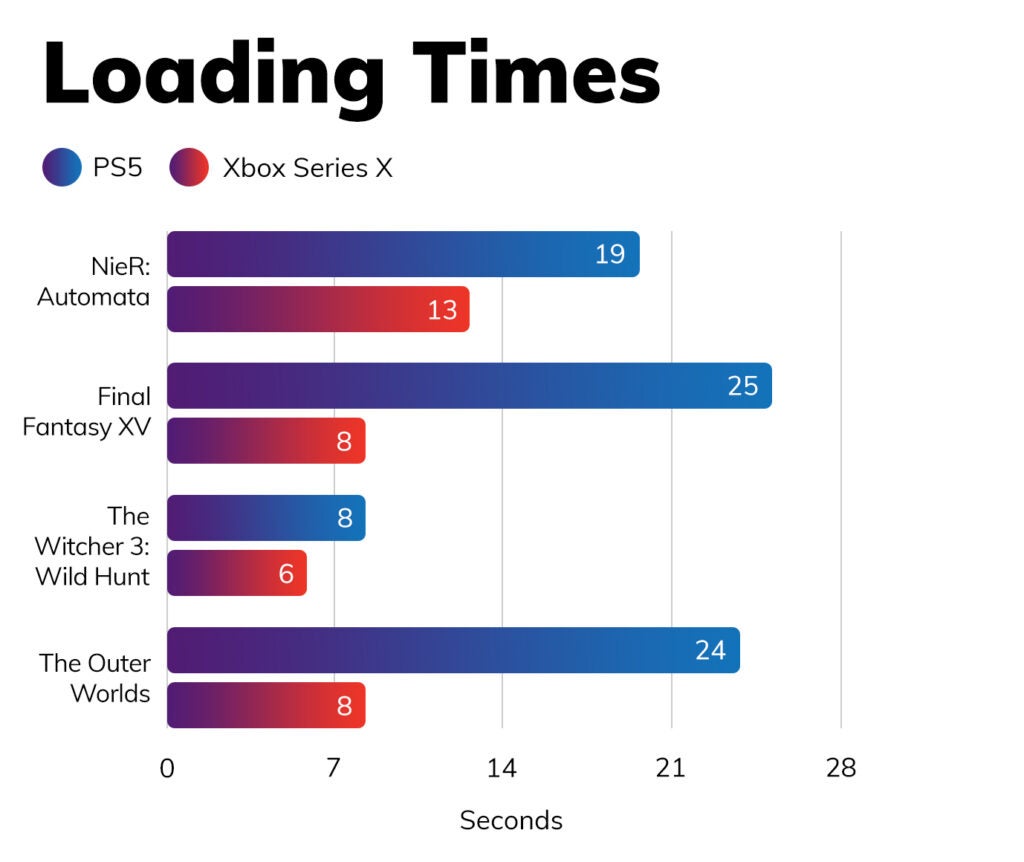
Microsoft’s commitment to backwards compatibility in the previous generation has come home to roost, with the storage architecture and seasoned emulation doing much of the heavy lifting when ensuring that existing titles are dramatically improved on the new console.
Despite costing far less, the Xbox Series S also outperforms the PS5 when it comes to backwards compatibility, delivering loading times that are only a few seconds behind its older sibling in most instances. There’s a solid possibility that the PS5 will catch up through future firmware updates, since while its SSD technology can achieve far more than the average PC right now, it hasn’t been optimised to support its legacy in the best way possible.
A gap of 10 seconds or so in the majority of games may not sound like much, but combined with the lack of a feature such as Quick Resume, it’s significant – especially where I was using the consoles side-by-side over a number of weeks. Complaints aside, the improvements across the board compared to the PS4 Pro remain very impressive, and sole owners of the PS5 likely won’t notice much of what I’ve addressed here.
Related: Breath of the Wild 2
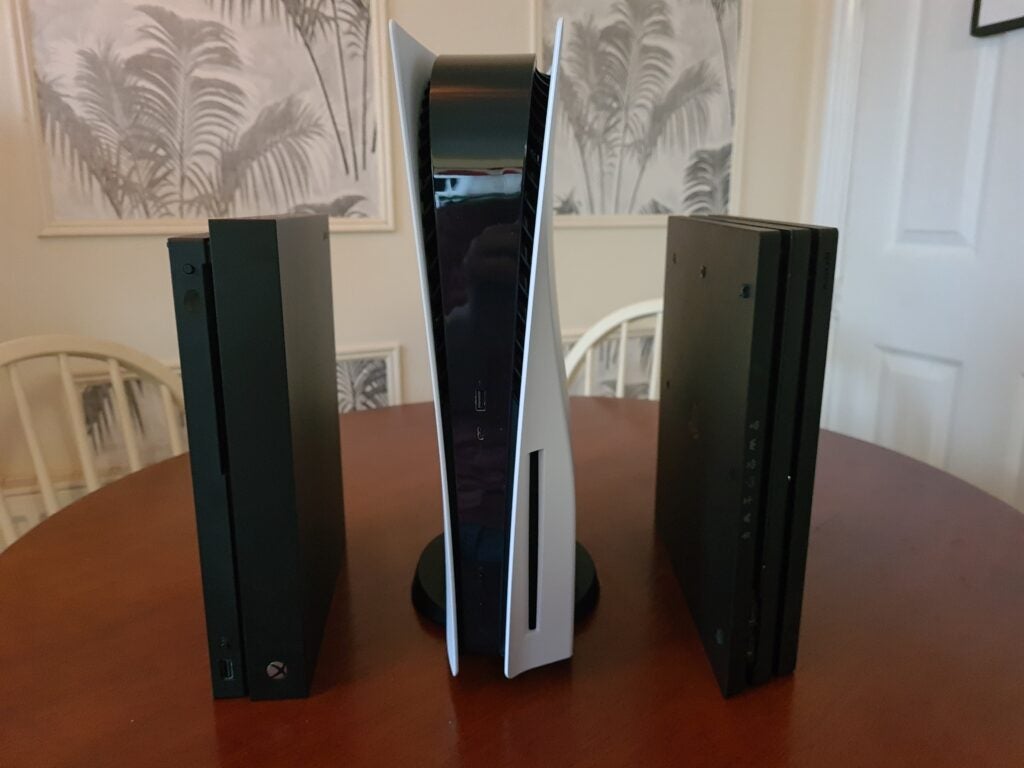
The seamless nature of accessing your existing library is wonderfully implemented. The PS5 houses your entire library across the new console, PS4 and PSVR. You can find them all in the user interface, and digital products can be downloaded at a moment’s notice. I only found a handful of titles that weren’t supported such as Metal Gear Survive, Battlefield 5 and Marvel vs Capcom: Infinite.
These are all random examples, with the correlation between them unclear, but through testing I’ve found that the majority of existing PS4 titles are supported without any trouble at all. If the game in question happens to have an unlocked frame rate or variable resolution, the PS5 will automatically enhance until the title reaches its natural boundaries – which was the case with Knack 2, Final Fantasy XV and Infamous Second Son.
Unlike the Xbox Series X, backwards compatibility is far less constrained by the original console, since the PS4 oftentimes reached 1080p with no trouble at all; the Xbox One was far behind in this regard. As such, with the exception of the complicated nature of PSVR titles, PS5 makes its previous iterations obselete. Those after a new platform that won’t displace their existing libraries won’t be disappointed by the PS5.
But enough about backwards compatibility; you’re likely more interested in how games developed exclusively for the PS5 will make use of the hardware. I’ve yet to get my hands on Demon’s Souls and Ratchet and Clank: Rift Apart, but Insomniac Games’ Spider-Man: Miles Morales does a phenomenal job of proving how real-time ray tracing and improved performance can alter a gaming experience for the better.
Let’s start with the visuals. Ray tracing allows developers to implement far more realistic lighting, reflections and other graphical enhancements to their games, reflecting reality far more accurately. This is a step up from the pre-baked solutions we’ve seen up until recently. Acting as the first real example I’ve seen on console, Spider-Man: Miles Morales is positively astounding in its implementation. You can find a direct comparison below, and the differences are night and day.

You’ll notice that the billboards of Times Square now reflect into the glass of buildings, instead of being filled by generic images of skyscrapers. Miles Morales and all of his movements are also recreated two-fold thanks to ray tracing, offering a more nuanced vision of the superhero as he swings through Manhattan.
Upon switching to Performance mode, everything just feels more lifeless by comparison. Granted, it does earn you far more frames per second for more responsive combat and exploration, but I found the gorgeous graphics were more than worth such a sacrifice. Devil May Cry 5: Special Edition handles things similarly. You can choose between modes that prioritise visuals or performance, with only one supporting ray tracing.
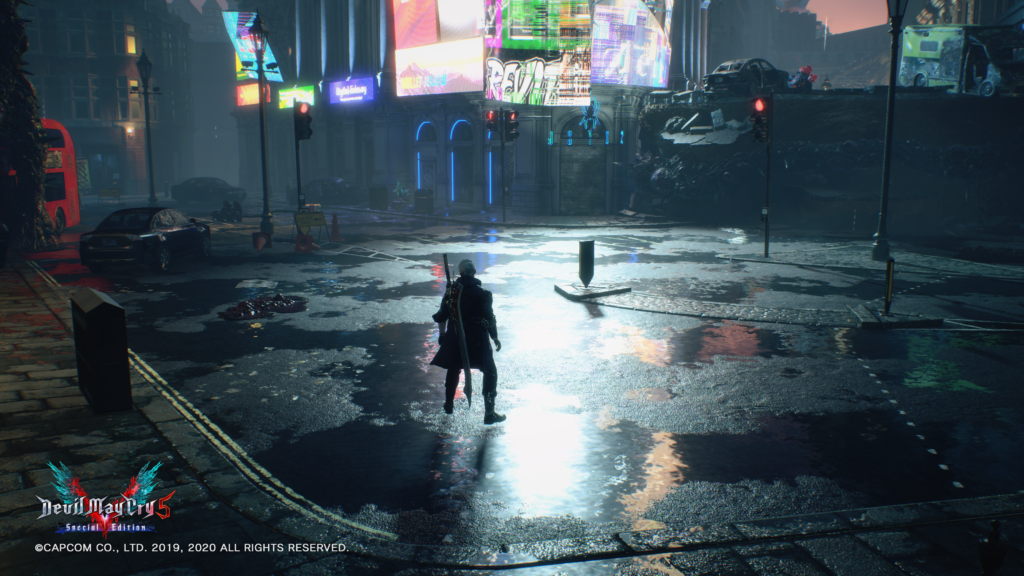
The resolution of reflections in Devil May Cry 5 are notably lower than those in Miles Morales. This can make some instances of the technique look blurry and obtrusive, which takes away from the impact it can have on the lighting in scenes. As you can see from the above screenshots, ray tracing fundamentally alters the mood of the scene, with light sources from the billboards and vehicles reflecting into the puddles and back onto the player.
Without ray tracing, the environment is far darker and lacking vibrancy, with harsh lights from the Piccadilly Circus-esque scene blasting onto the protagonist with little flair. In my opinion it still looks excellent, and expresses the mood of the game well, but ray tracing adds a further dimension to proceedings that simply feels more inviting.
All of the games I’ve tested with the feature have impressed – but if this isn’t important to you then the benefit of added performance is there as a compromise. I’m keen to see how the technology will be used in varying genres in the years to come, with Cyberpunk 2077 and Resident Evil 8 being just a couple of titles that could make use of ray tracing. For now, it remains an awesome yet underappreciated feature of each new console.
The PS4 and PS4 Pro have become infamous for how loud they are when switched on, so much so that the gaming audio is often drowned out by the abrasive fan noise emanating from the console. It made using them a nuisance, so I’m relieved to confirm that the PS5 is whisper quiet.
Even when running its most demanding experiences, it hardly makes a peep. It only makes itself heard when installing games from a disc or powering up other blu-ray media as the 4K drive springs to life. Even here, it’s far calmer than its predecessor.
Related: Call of Duty – Black Ops Cold War
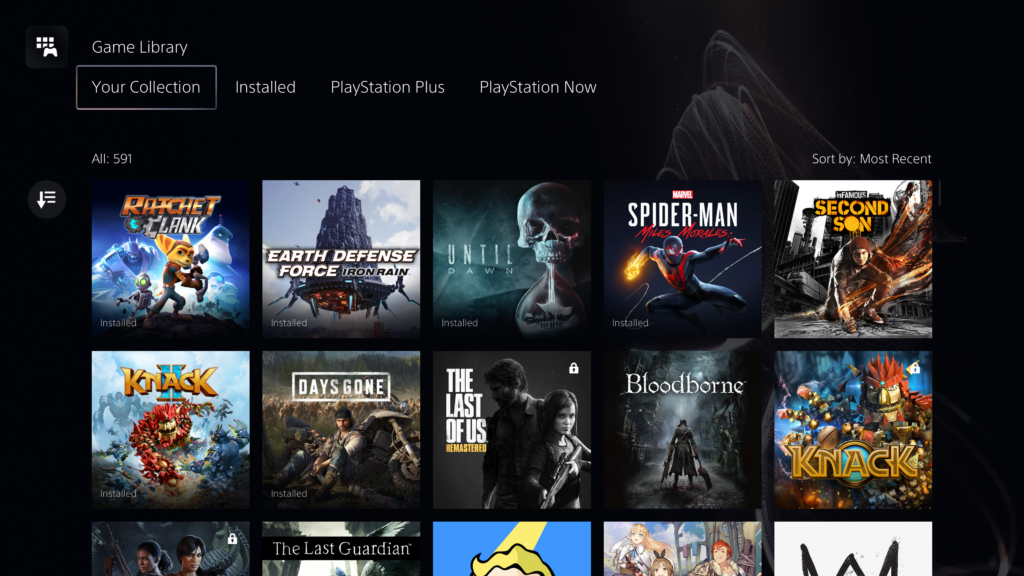
The DualSense controller is what really defines the PS5 as a true next-gen platform. It’s a meaningful evolution over the Dualshock 4, introducing new features that, if embraced properly, will no doubt characterise gaming for years to come. We’ll go into further depth in the dedicated review, but the introduction of adaptive triggers and a haptic feedback vibration serve to increase immersion to untold levels. Astro’s Playroom, which comes pre-installed on all consoles, is the perfect case study for the controller.
Team Asobi’s platformer delivers a masterful introduction to the DualSense controller, implementing haptic feedback and adaptive triggers into a variety of gameplay mechanics. These include springing about the environment and smashing through glass in a futuristic robot suit, or feeling the patter of rain against your little robot’s umbrella through your palms.
The pushing and pulling of obstacles is reflected in the triggers, with more or less force required depending on what is being achieved. It’s difficult to describe without having experienced it for yourself – but it’s a concrete transmutation of how I’ll view the medium from now on, and I desperately hope that studios the world over take full advantage.
However, some disabled players won’t be able to make use of these features, so Sony makes turning them off super-easy. Haptic feedback and adaptive triggers are used to varying degrees across all of the games I’ve tested thus far, but Astro’s Playroom is unquestionably the most impressive, and a title I implore all future owners of the platform to play to completion.
Spider-Man: Miles Morales and Devil May Cry 5: Special Edition have the triggers react to the swing of a web or the slashing of swords, recreating what such actions would feel like in reality using vibration. As for battery life, the DualSense offers a decent step up from the Dualshock 4. During my testing it lasted for a maximum of 13 hours and 11 minutes before needing to be plugged in for a charge, which is a colossal improvement over its predecessor. Obviously, mileage will vary depending on what applications are being used.
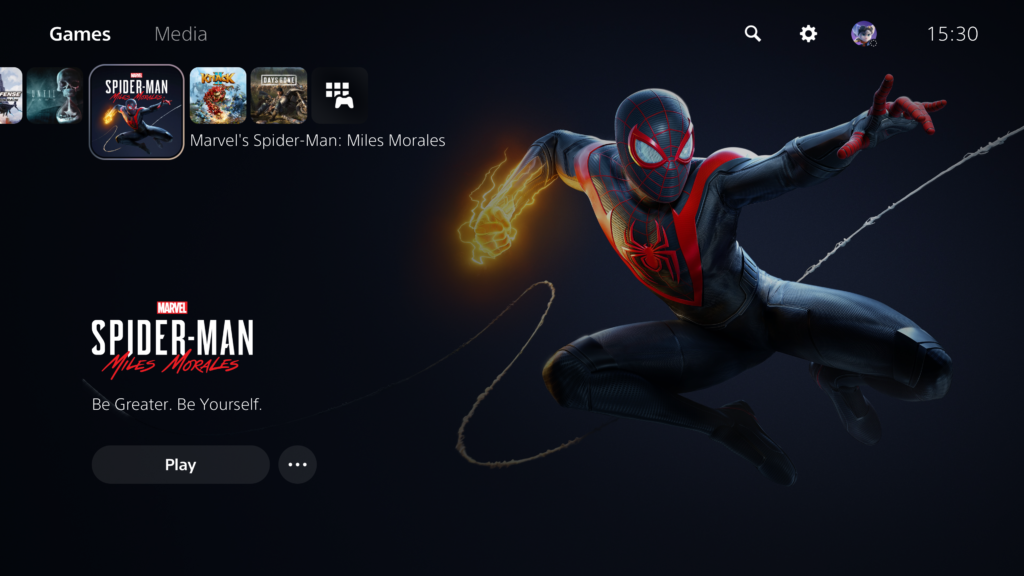
PS5 Review – User Experience
The PS5’s user interface feels like a natural expansion of what came before it. Sony has kept the tiles that defined the PS4, but has made them smaller and less intrusive, leaving room for spectacular artwork to fill the screen alongside a few menus.
Before I go into detail, it’s worth noting that the UI renders at a full 4K resolution with HDR for supported displays. As a result, everything pops with absurd levels of detail. It’s sharp, colourful and every single icon reveals elements that simply weren’t as clear before. The console’s horsepower is being put to the test before a game is even launched, and having just dropped £1000 on a new television, I’m certainly not complaining.
A single press of the PlayStation button will bring up the Control Centre, which is home to all the information you’ll need. Downloads, friends, music, notifications and your own profile are present and can be accessed with ease. The Control Centre can be brought up whether you’re mid-game or on the homescreen – and it’s seamless, with no sign of lag even when playing demanding games such as Spider-Man: Miles Morales. You can also customise the icons housed within to fit personal preferences.
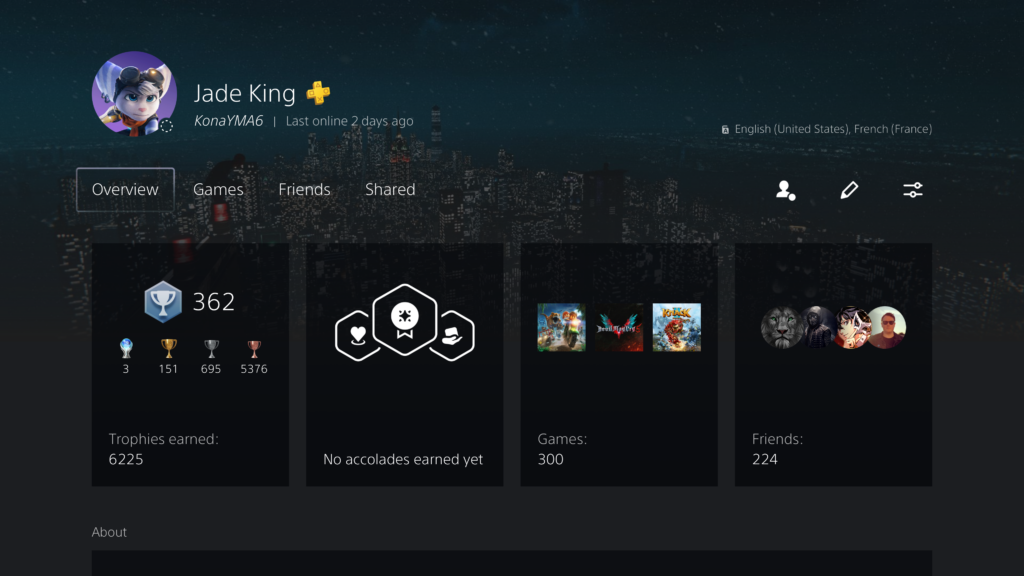
In-game, relevant trophies and activities will surface based on what you’re playing. For PS5 exclusives, these will include guides, news and other nifty content that aims to make gameplay more convenient. I’ve yet to bring up a guide myself, but for more casual players or completionists, this will sound like an intriguing idea. You can also launch straight into levels from here, once again showcasing the obscene speed of the internal SSD.
I’m unable to share exactly how media applications and the PlayStation Store works on the PS5, since the current iterations aren’t final, with updates set to arrive before launch. This review will be updated to reflect how they work in the coming days. But those who wish to use the PS5 as a multimedia hub can rest easy: all of the expectant bells and whistles are present and accounted for. At launch some of the confirmed media apps include Netflix, Disney Plus, Crunchyroll, Apple TV+ and YouTube. You can also bring up Spotify when using the majority of games and applications.
In its current state, only a select number of titles can be kept on the homescreen at once, with your latest applications cycling in and out depending on usage. There’s no folder support for those who crave organisation, and themes have seemingly been abandoned in favour of the high-resolution artwork that accompanies each game. It isn’t the end of the world, but having been such a core part of the PS4, I’ve sorely missed these elements of personalisation.
Related: Xbox Series X vs Xbox Series S
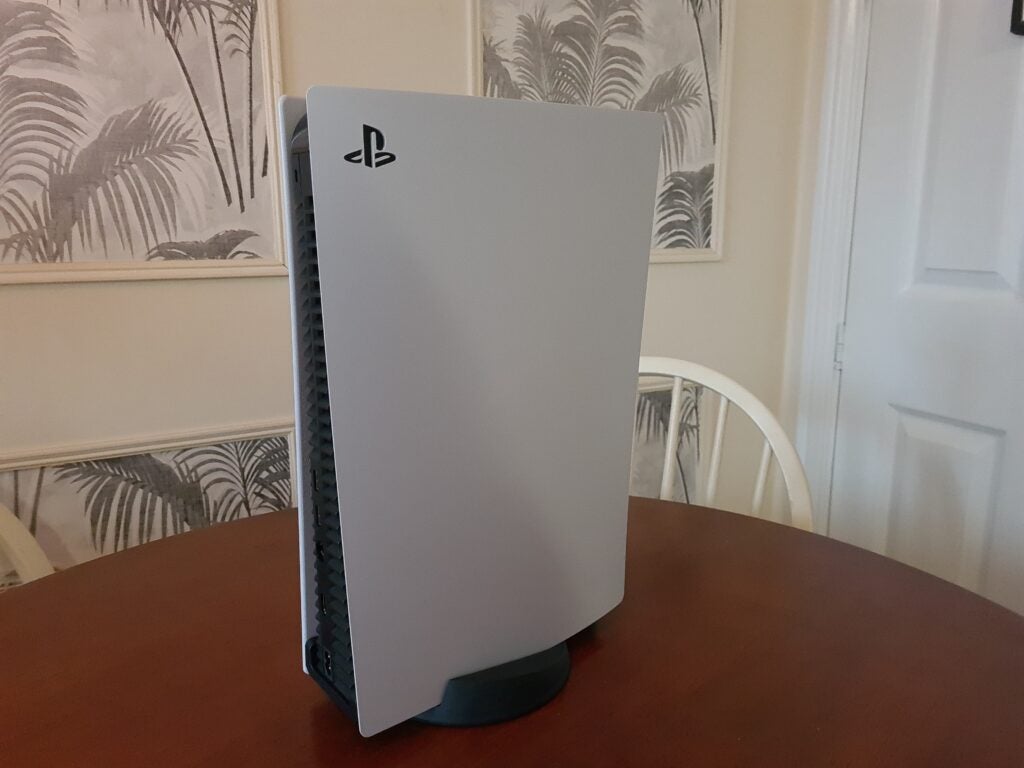
Verdict – Should you buy the PS5?
The PS5 is a meaningful evolution of Sony’s achievements with its predecessor. It’s a gorgeously accessible machine with a forward-thinking plan for the coming generation, whether that’s through its nuanced SSD technology or growing library of worthwhile exclusives.
This is yet another winner from the Japanese company, even if it lags behind the Xbox Series X and Xbox Series S in a handful of areas. It lacks the same snappy loading times, and the absence of a rival feature to Quick Resume can make it feel archaic in the wrong circumstances.
However, these are minor niggles in a console that impresses overall. In particular, with its DualSense controller, which teases a level of immersion that feels legitimately futuristic. This isn’t a quality-of-life improvement on what we already have; it’s breaking down walls and discovering levels of immersion the medium has never reached before.
Combine this with a compelling user interface, strong slate of launch experiences and a general ecosystem that embraces what came before it, and the PS5 is one of the best openers to a new generation we’ve had in some time. Once developers begin to truly test this new hardware, we’re all in for a treat.
The post PS5 Review: A brilliant machine which feels both futuristic and familiar appeared first on Trusted Reviews.
0 commentaires:
Enregistrer un commentaire